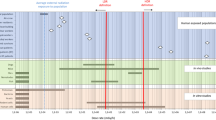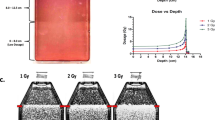Abstract
We aimed to verify the “saddle-shaped” dose-survival effect of microbes in response to heavy ion beam irradiation (HI), and further determine the radiation parameter that affects saddle shape formation, and the relationship between the saddle region and the positive mutation rate. A bibliometric analysis was performed based on literature containing the dose-survival effect of microbes in response to HI, from which the data on the particle energies, ionic types, irradiated microbes, survival curves, and maximum positive mutation rates were assembled. Articles reporting a “saddle-shaped” survival curve accounted for 64% of the total relevant articles and possessed a high cited frequency. The predominant articles, authors, and institutions that reported the dose-survival effect of microbes in response to HI proposed the “saddle-shaped” survival curve. It was customarily low-energy (but not moderate- or high-energy) HI that induced the “saddle-shaped” dose-survival effect. In addition, the “saddle-shaped” dose-survival effect was general among ~ 30-genera microbes. More importantly, most of the saddle regions contained the survival fractions within 10–30%, which are customarily used to screen mutants due to a high positive mutation rate. Further, 87% of the maximum positive mutation rates were associated with the saddle region, and 58% were located in the peak of the saddle region. “Saddle-shaped” dose-survival effect is a reliable and general phenomenon among varieties of microbes customarily in response to low-energy HI. Meanwhile, saddle region is always accompanied with high positive mutation rates. Thus, this study will aid in microbial mutation breeding practices.






Similar content being viewed by others
References
Chen CM (2006) CiteSpace II: detecting and visualizing emerging trends and transient patterns in scientific literature. J Assoc Inf Sci Technol 57:359–377. https://doi.org/10.1002/asi.20317
Cheng YR, Sun ZJ, Cui GZ, Song X, Qiu C (2016) A new strategy for strain improvement of Aurantiochytrium sp. based on heavy-ions mutagenesis and synergistic effects of cold stress and inhibitors of enoyl-ACP reductase. Enzym Microb Technol 93-94:182–190. https://doi.org/10.1016/j.enzmictec.2016.08.019
Du Y, Huang S, Tan Z, Lin Y, Qiu G (1999) Determination of DNA single-strand breaks by low-energy heavy ion and analysis of dose–effect curves. Chin Sci Bull 44:711–715. https://doi.org/10.1007/BF02909709
Feng H, Yu Z, Chu PK (2006) Ion implantation of organisms. Mater Sci Eng R Rep 54:49–120. https://doi.org/10.1016/j.mser.2006.11.001
Fu J, Chen T, Lu H et al (2016) Enhancement of docosahexaenoic acid production by low-energy ion implantation coupled with screening method based on Sudan black B staining in Schizochytrium sp. Bioresour Technol 221:405–411. https://doi.org/10.1016/j.biortech.2016.09.058
Garfield E (2009) From the science of science to Scientometrics visualizing the history of science with HistCite software. J Inf Secur 3:173–179
Ge CM, Gu SB, Zhou XH, Yao RM, Pan RR, Yu ZL (2004) Breeding of L(+)-lactic acid producing strain by low-energy ion implantation. J Microbiol Biotechnol 14:363–366
Guo C, Wang J, Jin X, Jing X, Li R, Wei W, Li W (2007) Studies on advantages of heavy ions in radiotherapy compared with gamma-rays. Nucl Instrum Methods Phys Res Sect B-Beam Interact Mater Atoms 259:997–1003. https://doi.org/10.1016/j.nimb.2007.03.010
Guo XP, Zhang MM, Yan Q, Li WJ, Lu D (2016) A bibliometric analysis on the research focused on cell irradiated by heavy ion beam. J Rad Res Rad Proc 34:57–64
Hu W, Chen JH, Wu QH, Li WJ, Liu J, Lu D, Wang SY (2017a) The mutagenesis of Lactobacillus thermophilus for enhanced L-(+)-lactic acid accumulation induced by heavy ion irradiation. Braz Arch Biol Technol 60:e160337. https://doi.org/10.1590/1678-4324-2016160337
Hu W, Li W, Chen J (2017b) Recent advances of microbial breeding via heavy ion mutagenesis at IMP. Lett Appl Microbiol 65:274–280. https://doi.org/10.1111/lam.12780
Imai R, Kamada T, Araki N (2017) Clinical efficacy of carbon ion radiotherapy for unresectable chondrosarcomas. Anticancer Res 37:6959–6964. https://doi.org/10.21873/anticanres.12162
Jiang BL et al (2017) A high-throughput screening method for breeding Aspergillus niger with C-12(6+) ion beam-improved cellulase. Nucl Sci Tech 28(1). https://doi.org/10.1007/s41365-016-0157-8
Li Q, Wei ZQ, Li WJ (2000) Calculation of depth-dose distribution of intermediate energy heavy-ion beam. Chin Phys C 24:414–417
Li HG, Luo W, Gu QY, Wang Q, Hu WJ, Yu XB (2013) Acetone, butanol, and ethanol production from cane molasses using Clostridium beijerinckii mutant obtained by combined low-energy ion beam implantation and N-methyl-N-nitro-N-nitrosoguanidine induction. Bioresour Technol 137:254–260. https://doi.org/10.1016/j.biortech.2013.03.084
Li X, Wang J, Tan Z, Ma L, Lu D, Li W, Wang J (2018) Cd resistant characterization of mutant strain irradiated by carbon-ion beam. J Hazard Mater 353:1–8. https://doi.org/10.1016/j.jhazmat.2018.03.036
Lin X, Liu S, Xie G, Chen J, Li P, Chen J (2016) Enhancement of 1,3-dihydroxyacetone production from Gluconobacter oxydans by combined mutagenesis. J Microbiol Biotechnol 26:1908–1917. https://doi.org/10.4014/jmb.1604.04019
Liu J, Yao J (2004) Study on mutagenic breeding of Bacillus subtilis and properties of its antifungal substances. Plasma Sci Technol 6:2433–2436. https://doi.org/10.1088/1009-0630/6/4/018
Liu XB, Gu QY, Yu XB, Luo W (2012) Enhancement of butanol tolerance and butanol yield in Clostridium acetobutylicum mutant NT642 obtained by nitrogen ion beam implantation. J Microbiol 50:1024–1028. https://doi.org/10.1007/s12275-012-2289-9
Minohara S, Fukuda S, Kanematsu N et al (2018) Recent innovations in carbon-ion radiotherapy. J Radiat Res 51:385–392. https://doi.org/10.1269/jrr.10028
Nie GJ, Yang XR, Liu H et al (2013) N+ ion beam implantation of tannase-producing Aspergillus niger and optimization of its process parameters under submerged fermentation. Ann Microbiol 63:279–287. https://doi.org/10.1007/s13213-012-0471-2
Ning Z, Long Y (2008) Effect of N ion implantation on antioxidase activity in Blakeslea trispora. Radiat Phys Chem 77:1046–1049. https://doi.org/10.1016/j.radphyschem.2008.04.004
Ning Z, Long Y (2009) Mutation breeding of beta-carotene producing strain B. trispora by low energy ion implantation. Plasma Sci Technol 11:110–115
Shao CL, Yu ZL (1997) Studies on survival model for organism of plants and microbes irradiated by low energy ions. Nucl Tech 20:423–430
Song DJ, Yao JM, Shao CL, Yu ZL (1999) A possible mechanism of dose related survival of microorganism implanted by N+ ions. Nucl Tech 22:129–132
Song H, Chen X, Cao J, Fang T, Bai J, Xiong J, Ying H (2010) Directed breeding of an Arthrobacter mutant for high-yield production of cyclic adenosine monophosphate by N+ ion implantation. Radiat Phys Chem 79:826–830. https://doi.org/10.1016/j.radphyschem.2010.03.005
Song JY, Liu HX, Wang L et al (2014) Enhanced production of vitamin K2 from Bacillus subtilis (natto) by mutation and optimization of the fermentation medium. Braz Arch Biol Technol 57:606–612. https://doi.org/10.1590/S1516-8913201402126
Song X, Zhang Y, Zhu X, Wang Y, Chu J, Zhuang Y (2017) Mutation breeding of high avermectin B 1a-producing strain by the combination of high energy carbon heavy ion irradiation and sodium nitrite mutagenesis based on high throughput screening. Biotechnol Bioprocess Eng 22:539–548. https://doi.org/10.1007/s12257-017-0022-6
Tanaka A, Shikazono N, Hase Y (2010) Studies on biological effects of ion beams on lethality, molecular nature of mutation, mutation rate, and spectrum of mutation phenotype for mutation breeding in higher plants. J Radiat Res 51:223–233. https://doi.org/10.1269/jrr.09143
Tang ML, Wang SC, Wang T, Zhao SG, Wu YJ, Wu LJ, Yu ZL (2006) Mutational spectrum of the lacI gene in Escherichia coli K12 induced by low-energy ion beam. Mutat Res-Fundam Mol Mech 602:163–169. https://doi.org/10.1016/j.mrfmmm.2006.09.001
Wang P, Zhang LM, Zheng ZM, Wang L, Wang H, Yuan CL, Gong GH (2011) Microbial lipid production by co-fermentation with Mortierella alpina obtained by ion beam implantation. Chem Eng Technol 34:422–428. https://doi.org/10.1002/ceat.201000370
Wang C, Zhang LL, Xu H (2012) The effects of N+ ion implantation mutagenesis on the laccase production of Ceriporiopsis subvermispora. Biotechnol Bioprocess Eng 17:946–951. https://doi.org/10.1007/s12257-012-0125-z
Xie M, Zhang XL, Hu XP, Zhang YJ, Peng DL, Li Q, Li M (2018) Mutagenic effects of low-energy N+ ion implantation on the propamocarb-tolerance of nematophagous fungus Lecanicillium attenuatum. Biol Control 117:1–5. https://doi.org/10.1016/j.biocontrol.2017.08.017
Xu A, Yao J, Yu L, Lv S, Wang J, Yan B, Yu Z (2004) Mutation of Gluconobacter oxydans and Bacillus megaterium in a two-step process of l-ascorbic acid manufacture by ion beam. J Appl Microbiol 96:1317–1323. https://doi.org/10.1111/j.1365-2672.2004.02270.x
Xu TT, Bai ZZ, Wang LJ, He BF (2010) Breeding of D(−)-lactic acid high producing strain by low-energy ion implantation and preliminary analysis of related metabolism. Appl Biochem Biotechnol 160:314–321. https://doi.org/10.1007/s12010-008-8274-4
Yan S, Tang H, Wang S, Xu L, Liu H, Guo Y, Yao J (2014) Improvement of kojic acid production in Aspergillus oryzae B008 mutant strain and its uses in fermentation of concentrated corn stalk hydrolysate. Biotechnol Bioprocess Eng 37:1095–1103. https://doi.org/10.1007/s00449-013-1081-5
Yang YN, Liu CL, Wang YK, Xue JM (2013) Mutation effects of C2+ ion irradiation on the greasy Nitzschia sp. Mutat Res-Fundam Mol Mech 751:24–28. https://doi.org/10.1016/j.mrfmmm.2013.09.003
Yuan H, Zhou W, Wang J, Zhang SQ, Yao JM (2007) Enhancement of Gongronella sp. JG chitosanase production by ion beam implantation. Plasma Sci Technol 9:115–118
Zhang JF, Liu ZQ, Zheng YG (2013) Improvement of nitrilase production from a newly isolated Alcaligenes faecalis mutant for biotransformation of iminodiacetonitrile to iminodiacetic acid. J Taiwan Inst Chem Eng 44:169–176. https://doi.org/10.1016/j.jtice.2012.11.010
Zhang N, Jiang JC, Yang J et al (2018) Screening of thermotolerant yeast by low-energy ion implantation for cellulosic ethanol fermentation. Energy Source Part A 40:1084–1090. https://doi.org/10.1080/15567036.2018.1469692
Zhao G, Hou L, Lu M, Wei Y, Zeng B, Wang C, Cao X (2012) Construction of the mutant strain in Aspergillus oryzae 3.042 for abundant proteinase production by the N+ ion implantation mutagenesis. Int J Food Sci Technol 47:504–510. https://doi.org/10.1111/j.1365-2621.2011.02870.x
Acknowledgements
The authors would like to thank the colleagues at HIRFL for providing high-quality carbon ion beam irradiation.
Funding
This work was supported by Chinese Academy of Sciences Key Deployment Project (no. KFZD-SW-109), joint project of Chinese Academy of Sciences and Industrial Technology Research Institute (CAS-ITRI 201801), and the National Natural Science Fund of China (no. 11575259).
Author information
Authors and Affiliations
Corresponding author
Ethics declarations
Conflicts of interest
The authors declare that there are no conflicts of interest.
Research involving human participants and/or animals
N/A
Informed consent
Informed consent was obtained from all individual participants included in the study.
Additional information
Publisher’s note
Springer Nature remains neutral with regard to jurisdictional claims in published maps and institutional affiliations.
Electronic supplementary material
ESM 1
(PDF 430 kb)
Rights and permissions
About this article
Cite this article
Guo, X., Zhang, M., Gao, Y. et al. “Saddle-shaped” dose-survival effect, is it a general and valuable phenomenon in microbes in response to heavy ion beam irradiation?. Ann Microbiol 69, 221–232 (2019). https://doi.org/10.1007/s13213-019-1442-7
Received:
Accepted:
Published:
Issue Date:
DOI: https://doi.org/10.1007/s13213-019-1442-7




